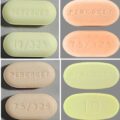What is Vicodin?
Vicodin is a strong prescription pain medicine that contains an opioid (narcotic) that is used to manage pain severe enough to require an opioid pain medicine, when other pain treatments such as non-opioid pain medicines do not treat your pain well enough or you cannot tolerate them. Vicodin is an opioid pain medicine that can put you at risk for overdose and death. Even if you take your dose correctly as prescribed you are at risk for opioid addiction, abuse, and misuse that can lead to death. On the other hand, Percocet (oxycodone and acetaminophen) is a combination drug consisting of an opioid and a pain reliever and fever reducer (analgesic and antipyretic) used for the management of moderate to severe pain, usually for an extended time period. SEE: How to Spot Fake Percocet
Are Vicodin and Percocet the same thing?
Vicodin (hydrocodone and acetaminophen) and Percocet (oxycodone and acetaminophen) are combinations of a narcotic and a non-narcotic pain reliever used for the relief of moderate to severe pain.
Differences and Similarities between Vicodin and Percocet in Terms of Use
Vicodin and Percocet are opioid narcotic medications. Morphine also belongs to this class. The U.S. Drug Enforcement Administration classifies opioids as Schedule 2 drugs. This means they have a high risk of abuse and could lead to a physical or psychological dependence (addiction).
Vicodin and Percocet are both prescribed to treat moderate to severe pain. For the most part, they should only be prescribed to treat acute or short-term pain caused by an injury or surgery. However, in some cases, these drugs may be prescribed to treat chronic or long-term pain due to conditions such as arthritis or cancer.
Opioids work by interfering with the way pain signals are sent through your central nervous system (CNS) to your brain. This reduces the pain you feel and makes movement and everyday activities easier.
Differences and Similarities between Vicodin and Percocet in Terms of Dosage Forms
Both Vicodin and Percocet come in brand-name and generic versions. The brand-name versions come in tablet form. The generic versions of come in tablet and liquid forms.
Vicodin:
- Vicodin tablets: 300 mg of acetaminophen with 5 mg, 7.5 mg, or 10 mg hydrocodone
- Generic tablets: 300 mg or 325 mg of acetaminophen with 2.5 mg, 5 mg, 7.5 mg, or 10 mg hydrocodone
- Generic liquid: 325 mg acetaminophen with 7.5 mg or 10 mg hydrocodone per 15 mL
Percocet:
- Percocet tablets: 325 mg of acetaminophen with 2.5 mg, 5 mg, 7.5 mg, or 10 mg oxycodone
- Generic tablets: 300 mg or 325 mg of acetaminophen with 2.5 mg, 5 mg, 7.5 mg, or 10 mg oxycodone
- Generic liquid: 325 mg acetaminophen and 5 mg oxycodone for every 5 mL
Vicodin or Percocet is typically taken every four to six hours as needed for pain.
What are possible side effects of Vicodin?
Common side effects of Vicodin include:
- lightheadedness,
- dizziness,
- anxiety,
- nausea,
- vomiting,
- upset stomach,
- drowsiness,
- constipation,
- headache,
- mood changes,
- blurred vision,
- ringing in your ears,
- dry mouth, and
- difficulty urinating.
What are possible side effects of percocet?
Common side effects of Percocet include:
- constipation,
- nausea,
- vomiting,
- upset stomach,
- sleepiness,
- drowsiness,
- dizziness,
- lightheadedness,
- itching,
- headache,
- blurred vision,
- dry mouth,
- sweating, and
- decreases in the ability to feel pain.
Tell your doctor if you experience serious side effects of Percocet including:
- respiratory depression,
- apnea (periodic stoppage of breathing),
- respiratory arrest,
- circulatory depression,
- low blood pressure (hypotension),
- shock, and
READ: Molly Percocet : 5 Things You Should Know
What drugs interact with Vicodin?
Patients receiving other narcotics, antihistamines, antipsychotics, antianxiety agents, or other CNS depressants (including alcohol) concomitantly with hydrocodone bitartrate and acetaminophen tablets may exhibit an additive CNS depression. When combined therapy is contemplated, the dose of one or both agents should be reduced.
The use of MAO inhibitors or tricyclic antidepressants with hydrocodone preparations may increase the effect of either the antidepressant or hydrocodone.
What drugs interact with Percocet?
Who should not take Percocet?
Do not take Percocet if you are allergic to any of its ingredients.
If you develop signs of allergy such as a rash or difficulty breathing stop taking Percocet and contact your healthcare provider immediately.
Do not take more than 4000 milligrams of acetaminophen per day. Call your doctor if you took more than the recommended dose.
Patients should be aware that Percocet tablets contain oxycodone, which is a morphinelike substance.
Patients should be instructed to keep Percocet tablets in a secure place out of the reach of children. In the case of accidental ingestions, emergency medical care should be sought immediately.
When Percocet tablets are no longer needed, the unused tablets should be destroyed by flushing down the toilet.
Patients should be advised not to adjust the medication dose themselves. Instead, they must consult with their prescribing physician.
How should Vicodin be taken?
Do not change your dose. Take Vicodin exactly as prescribed by your healthcare provider.
Use the lowest dose possible for the shortest time needed.
Take your prescribed dose every four to six hours as needed for pain. Do not take more than your prescribed dose. If you miss a dose, take your next dose at your usual time.
Call your healthcare provider if the dose you are taking does not control your pain. If you have been taking Vicodin regularly, do not stop taking Vicodin without talking to your healthcare provider. After you stop taking Vicodin, the unused tablets should be disposed of by flushing down the toilet.
How should Percocet be taken?
Dosage should be adjusted according to the severity of the pain and the response of the patient. It may occasionally be necessary to exceed the usual dosage recommended below in cases of more severe pain or in those patients who have become tolerant to the analgesic effect of opioids. If pain is constant, the opioid analgesic should be given at regular intervals on an around-the-clock schedule. Percocet tablets are given orally. ALSO SEE: Vicodin vs Norco: Differences, Similarities, Side Effects
How can I prevent an accidental overdose on prescription opioids?
Know what you are taking: Go online to www.drugs.com/pill_identification.html to learn what pill you are taking, and the dose. 5mg of Vicodin is not the same as 5mg of Percocet or 5mg of Methadone. Know the difference between short-acting, long-acting, and extended release. Extended release contains more of the drug and lasts longer.
Avoid mixing opioids with alcohol and other drugs: Do not mix opioid medications with alcohol or other drugs. Drugs with the same effects (i.e., downers like opioids and alcohol) can dangerously slow breathing. For drugs with opposite effects (like taking opioids with stimulants), you may take too much of the downer because you can’t feel its full effects.
Know your tolerance: If you have a period of not taking your prescribed opioid and then start taking it again talk to your doctor first! It may take less of the medication to have the same effect. Also, if you are sick, tired, haven’t eaten, or have lost weight, your tolerance may be lower.
Avoid using other than as directed: Prescription medications can take a long time to have their full effect. Keep this in mind if you think the medication is not working fast enough. Never chew, cut, crush, or dissolve opioid tablets or capsules and talk to your doctor if you need to take more medication than prescribed to get pain relief – you may need a different dose or type of medication.
Remember: Always follow proper dosing and let your doctor know if you are in drug treatment or are taking any other medications!
Where can i find more information and learn about treatment options in my area?
- Find out more about harm reduction at harmreduction.org.
- Find a treatment provider near you using the Substance Abuse Treatment Facility Locator.
- Visit Narcotics Anonymous for more information or to find a meeting.
- Visit Alcoholics Anonymous for more information or to find a meeting.
READ: Mexican Xanax Bars: Uses, Side Effects, Addiction, Street Value






